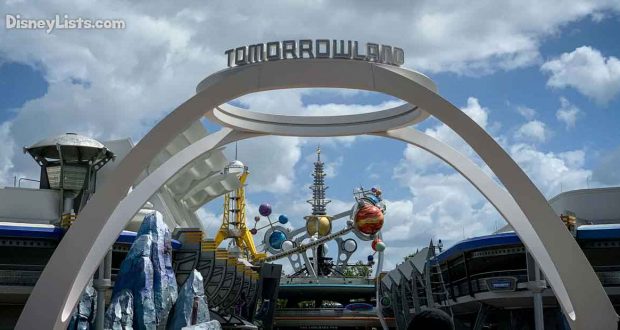
“There’s a great big, beautiful tomorrow…”
“There’s a great big, beautiful tomorrow, shining on the end of every day. There’s a great big, beautiful tomorrow, and tomorrow’s just a dream away.”
Singing a jingle almost got me kicked out of Disneyland. Well not the whole park; just the Carousel of Progress, also known as General Electric’s Tomorrowland. And not just me. Ethan Reilly and me together.
It was April of 1971. Walt Disney World would open later that fall in Florida, but for now, there was still just one Magic Kingdom: the original one, the real one, the California one. The one I had been hearing about it since it first opened in the 1950s when I was in elementary school.
Growing up in central Indiana, Disneyland was more like a fantasy than an actual destination: we didn’t know a single family who had traveled all the way to California. But now I was here. I was out of college between my junior and senior years. I had worked and saved money for most of the year, and now I had traveled by thumb from Indianapolis to Chicago, by train from Chicago to Denver, then more hitchhiking and using ride boards to get to Boulder, Salt Lake City, and Las Vegas. Then by bus across the Mojave Desert to Los Angeles.
“There’s a great big, beautiful tomorrow…”
Once arrived in LA, I had taken myself to see the canyons (Laurel and Topanga), the Pacific Ocean, the Venice boardwalk, the Santa Monica Pier, the La Brea Tar Pits, the LA County Art Museum, the LA Farmers Market, and the campus of UCLA, including their splendid Botanical Gardens. I had also attended a boring party consisting mostly of college kids who knew each other from North Hollywood High School. I had spent a day with Margie, a transplant from Indianapolis, who was a year or two ahead of me in school and had moved to Santa Monica with her family. Another day with the mother of my college friend Reinier, who also lived in Santa Monica and was the landlady for a building with five other units. I had also been lucky enough to find out about the LA Free Dental Clinic, because I had to go there, twice, to get a root canal for what turned out to be a seriously impacted tooth. I had attended a crowded lecture by the German leftist, the widely acclaimed Dr. Herbert Marcuse.
It was time to see the Magic Kingdom. I had the perfect guide and companion with whom to do that—and he was willing to cut school for a whole day just to do it with me.
“There’s a great big, beautiful tomorrow, shining on the end of every day.”
I was staying in North Hollywood in the home of my father’s friend, Hugh Reilly. They roomed together while attending the Northwestern University School of Speech from 1937 to 1941. They were both aspiring actors when they entered, but after the war, my dad had pivoted his theatrical talents to the courtroom, as an attorney. Hugh had come back from his experience in the Army Air Corps to have a successful and lucrative acting career, most famously playing the father in the “Lassie” TV series, opposite June Lockhart.
In recent years, his acting was more down-scale. He counted himself fortunate to have landed a part that year in the decades-old soap opera, “The Edge of Night.” That required him to live in New York City, but he had told my dad I could make his house in North Hollywood my home for as many weeks or months as I wished during my time away from college.
Hugh had driven all the way from the West Coast to the East Coast in a converted milk truck that he bought for $100. I would have thought that was an apocryphal story, but I was home in Indianapolis on the winter afternoon when he stopped for a couple of nights. I saw the milk truck with its uncomfortable stool for a seat and its accordion-style doors: fine for LA weather but poorly insulated against the midwestern chill. I saw Hugh come in and gratefully warm himself against the fire that my Dad made in our fireplace. I heard a splendid melodic voice coming from this now bearded man. He may have been talking about the traffic on I-70, but he sounded as regal, expressive, and compelling as if he were doing King Lear.
Hugh was cast as one of the villains in “The Edge of Night,” and typically, he told my family, a villain could only count on a couple of months of work before the script writers would kill him off. His solution to that? Get to know the writers, befriend them, have drinks with them, convince them to keep your character going! He did that, and “The Edge of Night” would keep him gainfully employed into1973.
Hugh had three sons—Dave, Josh, and Ethan–and was divorced from their mother, Jennifer. Dave and I were the same age (21), Josh was about 17 and Ethan was 14. Dave lived mostly in Hugh’s North Hollywood house. More specifically, he cooked his meals in the house but actually “lived” in a tent that he had set up in the fenced back yard in this modest middle-class neighborhood. He had a job and was taking classes at what was then called L.A. Valley Junior College. Josh and Ethan lived mostly with their mom in Claremont; they were still in high school and middle school, respectively. They spent a lot of their weekends and free time at their dad’s place.
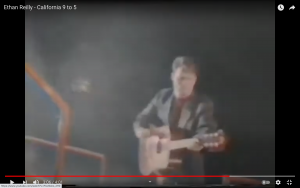
A screenshot of Ethan playing guitar, from video of his song, “California 9 to 5.” This was produced in about 1990, when he was about 34. See full video below.
According to the two older brothers, Hugh had rather gravely commanded them that while he was absent, they were to keep Ethan away from drugs. This was in grudging recognition that each of them had their own preferred illegal substances already and he was powerless to stop them. Dave and Josh resented this edict from Hugh, not because they wished to entice their brother into doing drugs, but because they thought their father was underestimating Ethan’s own sense of agency and autonomy. Ethan at that stage of his life was steadfast in his avoidance of drugs and they respected him for it.
Although Josh and Dave were generous with me and kind, and the peers they brought around were closer to my age, the whole crowd exuded a certain level of LA-hip that was beyond my comfort zone. I had even witnessed one of their friends, while hanging at the house, heat up a knife blade and carve the words DÉJÀ VU into a good-sized cake of hashish. This was a joke, in advance of a scheduled delivery of the hash to David Crosby (of Crosby, Stills, Nash, & Young)–“Déjà vu” being the name of the group’s most recent album.
Ethan and I immediately gravitated to one other’s company when he came around. As an eighth grader, he was still pretty hip—but just about right for my 21-year-old Midwestern and Harvard self. He was already a serious musician and one who was clearly demarcating his own path, integrating rock and roll with country and western before that fusion was widely celebrated. As a middle school kid, his talent had somehow attracted the attention of Michael Nesmith (formerly of the Monkees, and now with his own First National Band). Nesmith had gifted Ethan with his first pedal-steel guitar, which he was in the process of mastering.
Ethan and I happily frittered away many hours of one glorious southern California day trying to track down an album featuring Red Rhodes, a pedal-steel guitarist he admired. The title was Red Rhodes & The Detours/Live at the Palamino. By bus and by thumb and lots of walking, we made our way to the expansive headquarters of RCA Records in Hollywood, and then to the tiny premises of Happy Tiger Records, on Avenue of the Stars in Century City. For reasons they didn’t explain to us, they told us they had destroyed their entire stock of the Detours album. With that kind of business acumen, I didn’t find it surprising when I looked them up recently in Wikipedia to find out that they only were in business from 1969 to 1971.
“There’s a great big, beautiful tomorrow, shining on the end of every day.”
Hugh’s girlfriend Marilee (whom he would later marry and then divorce but with whom he always would remain friends) gave us a ride to the bus station during her lunch hour, and we took the bus to Anaheim for our Disneyland adventure.
It had crossed our minds before we went that we might possibly be barred from entering. Even though Walt Disney had been dead for a few years, all the kids in southern California knew that hippies and long-hairs were not welcome in his park—not as workers and not even as customers. Stories circulated of people being turned away. Ethan had shoulder-length brown hair but mine was just your average white college-boy length, and our hope was that his youth and wholesomeness would spare him being labelled a dirty hippy. We gained entry, and once inside, figured our only enemy would be the long lines robbing us of our time. Never did we anticipate that we might get in any trouble.
“There’s a great big, beautiful tomorrow, shining on the end of every day. There’s a great big, beautiful tomorrow, and tomorrow’s just a dream away.”
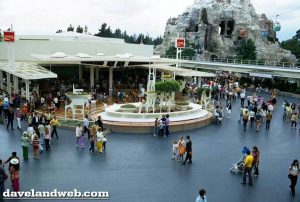 We had a great time. According to my travel journal, we were more than satisfied with “Pirates of the Caribbean,” the “Haunted Mansion,” and “Tom Sawyer’s Island.” I was not that impressed with the “Swiss Family Robinson house.” The only one that wasn’t worth it, especially given the amount of time we had to wait in line, was “the Matterhorn.”
We had a great time. According to my travel journal, we were more than satisfied with “Pirates of the Caribbean,” the “Haunted Mansion,” and “Tom Sawyer’s Island.” I was not that impressed with the “Swiss Family Robinson house.” The only one that wasn’t worth it, especially given the amount of time we had to wait in line, was “the Matterhorn.”
We had some burgers and something they called Mint Juleps, and headed over to the display of technology called the Carousel of Progress or Tomorrowland. This pavilion was created by Walt Disney as the prime feature of the General Electric (GE) Pavilion for the 1964 New York World’s Fair in New York City, and was moved to Tomorrowland a few years later. It is reported to be the last creative project on which Walt Disney personally invested time. (He died in 1966.) The internet says the display was in Anaheim only until 1973—and then moved to Orlando, FL for some additional years– so I guess Ethan and I just got lucky. As one can read on the Web, “the attraction’s premise is an exploration of the joys of living through the advent of electricity and other technological advances during the 20th century via a ‘typical’ American family.”
The audience sits in theatre seats as animatronic humans light up and speak and direct us to notice the various ways their family life is challenging, in the early decades of the twentieth century, and gets more comfortable as the decades pass, as General Electric creates irons, washing machines, electric lights, refrigerators, and a host of other wonderful products. By the end, we are witnessing our exciting future: voice-activated commands from across the room to one’s electric range; “Oven—turn up to 375 degrees!”
To Ethan and me, more awesome than the display of products was the jingle. “There’s a great big, beautiful tomorrow, shining on the end of every day. There’s a great big, beautiful tomorrow, and tomorrow’s just a dream away.” It was sung slowly and recurred every few minutes, in between each decade. Not only that: when they played the “talking machine” (Victrola) in the early part of the twentieth century, what tinny song do you think came out of it? You guessed it! “There’s a great big, beautiful tomorrow…”
The song was crafted by Richard and Robert Sherman—no slouches in the field of songwriting. Among other achievements, they are credited with many of the lyrics and melodies from Mary Poppins, including the wonderful Chim Chim Cher-ee.
By the time we heard the jingle for the fourth or fifth time we were only up to World War II and were getting restless. Ethan and I found ourselves clapping, stomping, and singing along! “There’s a great big, beautiful tomorrow, shining on the end of every day. There’s a great big, beautiful tomorrow, and tomorrow’s just a dream away.” Each time the song came around, we augmented the volume of our vocals and our clapping. Our enthusiasm was apparently infectious; by the third time we sang it, some little children in the very front row began singing too. The crowds were not large inside the pavilion—probably fewer than 25 in total, so not many people could have been disturbed as a consequence of our full-throated display. (Full transparency: we might have also made some sarcastic remarks about the centrality of electric can-openers in contributing to the quality of our lives.) Before you know it, a guard came over and warned us in a very stern voice, “Would you please hold it down?”
The first time you hear the jingle begins at 1:10. This is the entire show!
We did not think our embrace of the Sherman Brothers’ oeuvre needed to be disrespected that way. We skipped the last few minutes of the show and tripped right out of that Carousel of Progress. There was just time to ride around on the Monorail and hop on the train making loops around the parking areas, and then we had to join hundreds of other young people getting on buses back to LA. So, no, we weren’t really kicked out of Disneyland, or even out of Tomorrowland; we walked out with our heads held high. But it makes a better story to start it off that way.
The bus ride back to LA was a fitting coda to our day inside the Magic Kingdom. Ethan remembered from his one visit to our family in Indianapolis that my Dad had a ton of jokes he liked to tell, and he asked if I could go through and tell them, So I related to him the one about the cherry pie and the diamond ring, the one about the hunk of bologna, the one about the Pope and the Jews in the Vatican, and the one that ended with the punchline, “I was makin’ fun of the other guy!” When we got all talked and joked out—maybe because our earlier attempt at song had been snuffed out by the security guard—we began singing.
Ethan sang “The Wanderer” by Dion, and then I sang part of “The Lion Sleeps Tonight.” We were not being loud or boisterous, just enjoying ourselves as we allowed the fatigue of a long day to seep into our bodies. At one point, we realized several kids in banks of seats behind us were whispering about “those guys singing up there.” They were middle-school and high school-aged, all African-American. Then one of them yelled, ”sing louder!” We still weren’t sure they were referring to us, so I turned around and looked, and yes, there were more than a dozen kids looking my way and waiting for some more songs. So I turned to Ethan and in my best falsetto, began, “you got a smile so bright, ooh-ooh…” And he sang back, “you know you coulda been a candle.” And I sang “I’m holding you so tight, ooh-ooh,” and he sang,” You know you could be a handle.” We went on to sing that whole Temptations song, “The way you do the things you do.” Now the kids who asked us to sing louder were clapping along and smiling, and some white kids in other rows started doing the same. I sang one more with him and then I was about out of songs, but Ethan wasn’t. He could sound just like John Fogerty and he gave them some Creedence Clearwater Revival. And I’m not sure what else he sang, but he continued for at least ten minutes, and it was awesome. When he stopped, nearly the entire bus load gave a thunderous and enduring ovation. I even heard someone mutter, “wow, the Beatles, right on our bus.”
In just three years, Ethan would be dropping out of high school and touring Australia and other countries, playing pedal-steel guitar and singing backup with Glen Campbell and his band. None of the adulation those kids on the bus expressed was misplaced.
The kids were also not misplaced in associating Ethan with the Beatles. He would end up spending a big chunk of his career as the leader of a well-received Beatles tribute band, performing and living mostly in Germany.
Hugh Reilly, sadly, was not misplaced in asking his older sons to guard Ethan from substance abuse. It wasn’t the illegal stuff that got him, though. It was the old demon, alcohol, that would do him in and lead to his early death, in 2010 in Germany, at age 54. Hugh himself had passed more than ten years earlier and did not have to bear the burden of knowing of the demise of his youngest boy.
I last saw Ethan when we were seated together in New York City in 1999 at the wedding of my brother Hugh Fink—named after Hugh Reilly. Ethan performed a song with the wedding band, at my brother’s request.
In his final years, the Los Angeles Angels (previously, the California Angels) Major League Baseball team, used a song that Ethan wrote, performed, and produced, as their theme song. They would play it at the end of each home game, the way some teams play John Fogerty’s “Centerfield,” or the Red Sox play Neil Diamond’s “Sweet Caroline.” The song is titled “California Nine to Five,” and has great lyrics as well as a great hook for a melody. It fuses country/western and rock, featuring acoustic guitar and pedal-steel. The lyric mixes philosophy with baseball, the drudgery of commuting with the excitement of art and performance. “I’d give everything for one more chance to play.”
Ethan Reilly’s song, “California 9 to 5, ” played for several years at the conclusion of the L.A. Angels major league baseball games.
And I would give anything for one more chance to be on that bus with Ethan. Or even inside the Tomorrowland Pavilion, getting hassled by the guard as we join in belting out one more round of that jingle.
Dale Borman Fink retired in 2020 from Massachusetts College of Liberal Arts in North Adams, MA, where he taught courses related to research methods, early childhood education, special education, and children’s literature. Prior to that he was involved in childcare, after-school care, and support for the families of children with disabilities. Among his books are Making a Place for Kids with Disabilities (2000) Control the Climate, Not the Children: Discipline in School Age Care (1995), and a children’s book, Mr. Silver and Mrs. Gold (1980). In 2018, he edited a volume of his father's recollections, called SHOPKEEPER'S SON.


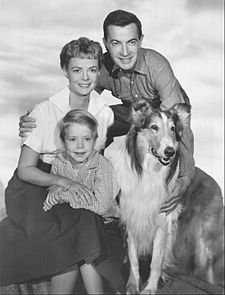
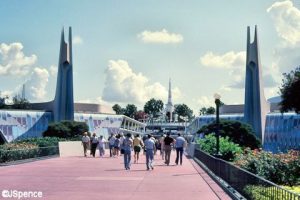

You’ve described a joyous celebration of youth, Dale. Wonderful, vivid recollections with some ready-made talented friends. So nice that you received some love from the kids on the bus. The ebb and flow of the lives of Hugh’s kids is interesting and revealing. Great that your dad stayed friendly with him throughout their lives. I understand the pull from theatre to the legal profession, as I was a theatre major at Brandeis. When my dad asked me what I would do with that, while home my junior year, I brightened up and remarked, “Maybe go to law school?” He was over the moon, but I wasn’t serious. I got me teaching certification instead (to no avail; no jobs to be had in the Boston suburbs in 1974).
We first visited Disneyland in 1989 (I was 5 months pregnant…not fun to traipse around in that condition!) when my dad lived in SoCal and we had a 3 year old. All those giant characters scared the crap out of him, but it was truly a marvelous conception. We took the whole family to DisneyWorld when everyone was older and could appreciate it more. We stayed on the property, had my in-laws along and had a great time. We even saw NASA launch a space shuttle (not too far away).
The jingle that sticks most in my mind (and I wanted to shoot the animatronics) was, of course, “It’s a Small, Small World”. That one gets under your skin very quickly.
I do not remember the “characters” hanging out at Disneyland in 1971–maybe that was a later innovation?
Yes, the bond my dad and Hugh Reilly maintained was extraordinary, even though their personal visits to each other were often separated by many years, even exceeding a decade between visits at times. And my Dad remained “theatrical” throughout his life, not only with his love for joke- and story-telling, but he would occasionally practice at home the dramatic closings he was planning for jury trials. And when called upon to conduct civil marriage ceremonies (which he had the right to do in Indiana), he could quote passages from Shakespeare without consulting any text.
The Web tells me the Disney parks have always had those life-sized characters! Funny, I guess I just walked around them and didn’t focus on them at all.
What a wonderful story of a memorable summer Dale, and bless your well-kept travel diaries!
But what about Ol Blue Eyes singing Kander and Ebb’s New York, New York after every game at Yankee Stadium?
This is great, Dale. I’d never gone to Disneyland as a child, so like you, was thrilled to get there, finally, in 1978. I was working for a medical instrument company and had to help set up a trade show at the Anaheim Convention Center over the weekend. When I was done I got to take an afternoon break and visit Disneyland. The characters were definitely there in force, and it was delightful (if somewhat hokey). My favorite memory is of the kids thoroughly enjoying themselves.